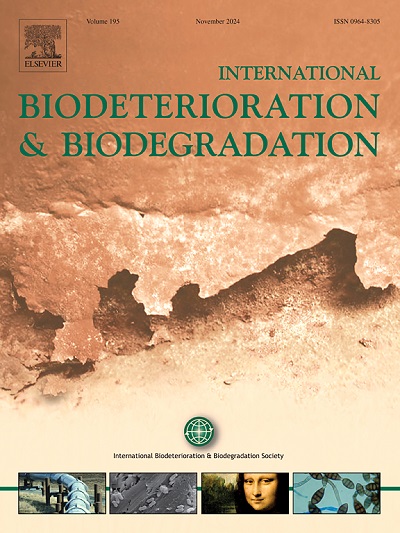在可控温度和环境温度下,生活污水处理过程中基质抑制厌氧氨氧化的动态研究
IF 4.1
2区 环境科学与生态学
Q2 BIOTECHNOLOGY & APPLIED MICROBIOLOGY
International Biodeterioration & Biodegradation
Pub Date : 2025-06-30
DOI:10.1016/j.ibiod.2025.106158
引用次数: 0
摘要
研究了厌氧氨氧化移动床生物膜反应器(MBBR)在不同COD/N比和水力停留时间(HRTs)下处理合成废水和实际生活废水的动力学行为和运行性能。目的是评估总氮(TN)和化学需氧量(COD)的底物去除动力学,评估模型的适用性,评估和量化反应速率,并确定在实际生活污水处理过程中影响厌氧氨氧化活性的制约因素。采用一阶、Grau’s二阶和改进的Stover-Kincannon三种动力学模型对COD和TN的去除进行量化。结果表明,虽然一阶模型提供了有限的精度(R2 = 0.36),但Grau模型(R2 >;0.98)和stov - kincannon模型(R2 >;0.98)对COD和TN的去除率具有较强的预测性能。反应器在24 h HRT下TN去除率高达96%,COD去除率高达92%。然而,较高的COD/N比率(>8)大大抑制了特定厌氧氨氧化活性(SAA),在COD/N = 15时,特别是在环境条件下,抑制率高达92%。与合成废水和真实生活废水的性能比较进一步揭示了环境波动和复杂有机物对系统稳定性的影响,在受控和环境情景下,TN去除率从89%下降到82%。该研究强调了COD/N比管理、操作灵活性和模型引导反应器设计在维持厌氧氨氧化性能中的重要性。这些发现为优化Anammox-MBBR反应器在分散式污水处理应用中的合成和实际生活污水处理提供了新的见解。本文章由计算机程序翻译,如有差异,请以英文原文为准。

Substrate dynamics on anammox inhibition during domestic wastewater treatment under controlled and ambient temperature
This study investigates the kinetic behavior and operational performance of an Anammox-based Moving Bed Biofilm Reactor (MBBR) treating synthetic and real domestic wastewater under varying COD/N ratios and hydraulic retention times (HRTs). The objective was to evaluate substrate removal kinetics for total nitrogen (TN) and chemical oxygen demand (COD), assess model applicability, assess and quantify the rates of reactions and identify constraints affecting anammox activity during real domestic wastewater treatment. Three kinetic models: first-order, Grau's second-order, and modified Stover–Kincannon were applied to quantify COD and TN removal. Results showed that while the first-order model provided limited accuracy (R2 = 0.36 for COD), both the Grau's model (R2 > 0.98) and Stover–Kincannon model (R2 > 0.98) demonstrated strong predictive performance for both COD and TN removal. The reactor achieved up to 96 % TN removal and COD removal as high as 92 %, at 24 h HRT. However, higher COD/N ratios (>8) substantially suppressed Specific Anammox Activity (SAA), with up to 92 % inhibition at COD/N = 15, especially under ambient conditions. Comparisons of performance with synthetic and real domestic wastewater further revealed the impact of environmental fluctuations and complex organics on system stability, with TN removal declining from 89 % to 82 % from controlled to ambient scenarios. The study underscores the importance of COD/N ratio management, operational flexibility, and model-guided reactor design in sustaining anammox performance. These findings offer new insights into optimizing Anammox-MBBR reactor for synthetic and real domestic wastewater treatment in decentralized wastewater treatment applications.
求助全文
通过发布文献求助,成功后即可免费获取论文全文。
去求助
来源期刊
CiteScore
9.60
自引率
10.40%
发文量
107
审稿时长
21 days
期刊介绍:
International Biodeterioration and Biodegradation publishes original research papers and reviews on the biological causes of deterioration or degradation.

 求助内容:
求助内容: 应助结果提醒方式:
应助结果提醒方式:


